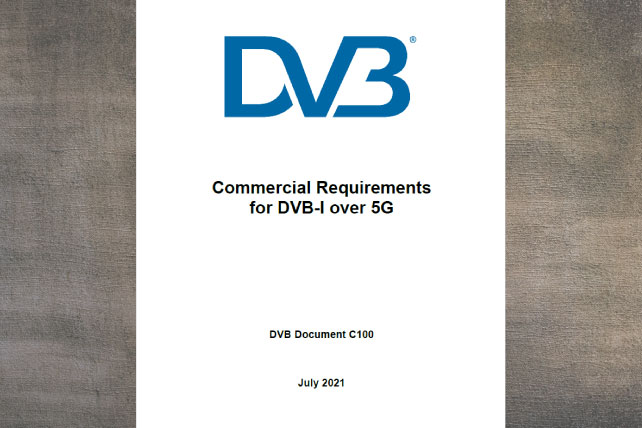The DVB Project has approved commercial requirements for DVB-I service support over 5G networks and systems. Work has already commenced in DVB’s Technical Module to provide extensions to the relevant existing specifications – including DVB-I service discovery and DVB-DASH – to address the use cases and requirements collected and agreed by the Commercial Module.
Earlier this month, the DVB Steering Board approved the publication of the commercial requirements, now available for download as DVB BlueBook C100. The document not only provides a set of 70 technical and procedural requirements, but also introduces key elements of 5G networks and systems related to media distribution including 5G Broadcast, 5G Media Streaming and other ongoing activities in 3GPP. In particular, LTE-based 5G Broadcast (as defined in ETSI TS 103 720) provides all functionalities to operate classical TV services including receive-only, free-to-air and high-power high-tower network infrastructures. The commercial requirements were developed based on six guiding use cases, all documented in an annex to BlueBook C100.
5G-based technologies promise to enable content and service providers to access mobile devices, typically interfacing with installable apps. 5G-based distribution to other types of receiver, such as moving vehicles, devices connected to roof-top mounted antennas or 5G-based home gateways, is not excluded. A particular benefit of DVB-I services over 5G is the ability to support integrated DVB-I hybrid services, i.e., services for which the basic broadcast distribution is augmented with unicast for extended service coverage, lower distribution costs, improved quality and additional user experiences.
Commercial requirements
The commercial requirements themselves are structured in technical and procedural aspects. Generally, the requirements ask for specifications to support different Rel-16-based 5G operation modes, namely 5G Broadcast, unicast-based 5G Media Streaming, concurrent delivery of the same service over both modes, and hybrid DVB-I services. In all cases it is expected that the specifications reuse existing DVB technologies to the extent possible and provide commonalities with other IP-based DVB delivery means.
The technically-oriented requirements are clustered in different service-operation phases, namely provisioning, announcement and detection, components, distribution and delivery, quality and monitoring, as well as client-related aspects. While the requirements are extensive and detailed, for example also including security-related aspects, it is expected that many are already covered by the existing DVB-I specification or would only demand minor extensions. This is a benefit of the original DVB-I design to provide a TV service platform independent of the access layer.
Collaboration
Beyond the technically-oriented requirements, C100 explicitly addresses different aspects related to collaboration.
First of all, collaboration is a key issue for potentially successful operation of DVB services over 5G, as broadcast service providers and 5G network operators need to collaborate to beneficially use DVB-I functionalities and 5G functionalities for DVB-I service distribution. This aspect is addressed in the requirements by asking the technical group to provide specifications for network and client-side interfaces and APIs to formalize the communication across these two business domains.
Secondly, the DVB-I over 5G system is expected to align with common industry practices, for example those developed in 3GPP, 5G-MAG or other organizations that contribute to successful deployment of media and TV services over 5G.
Finally, an important aspect in the development of DVB specifications is the availability of Verification and Validation (V&V) tools. Collaborative efforts with other organizations such as 5G-MAG, 3GPP or DASH-IF are expected to be initiated in order to support reference and interoperability efforts. As an example, the newly established 5G-MAG Reference Tool project may create synergies with V&V tools for DVB-I over 5G.
Specifications ready in 2022
Updates to relevant DVB specifications to fully support DVB-I over 5G are expected to be completed in Q3, 2022. However, with expected continuous extensions of 5G technologies in upcoming releases, the first release of DVB-I over 5G may be only the starting point in a long-lasting endeavour to enhance DVB-based TV services by also leveraging 5G-based distribution systems.
Download DVB BlueBook C100, Commercial Requirements for DVB-I over 5G, from our Specifications Library

